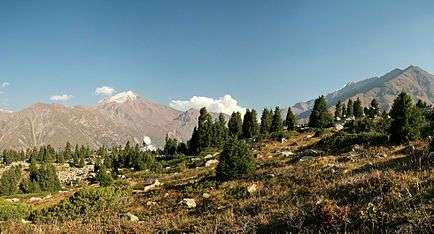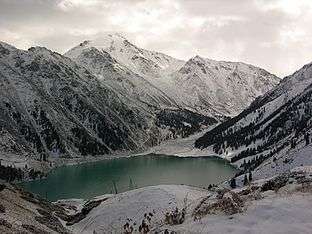Ile-Alatau National Park
| Ile-Alatau National Park | |
|---|---|
|
View of Big Almaty Lake | |
 Location of the Ile-Alatau National Park | |
| Location | Almaty, Almaty Region, Kazakhstan |
| Coordinates | 43°5′0″N 77°5′0″E / 43.08333°N 77.08333°ECoordinates: 43°5′0″N 77°5′0″E / 43.08333°N 77.08333°E |
| Area | 200 000 hа |
| Established | 1996 |
Ile-Alatau National Park is a national park in Kazakhstan. It was created in 1996 and covers about 200,000 ha. It is situated in the mountains south of Almaty between Gorge Turgen in the east and Chemlogan River in the west. The National Park borders Almaty Nature Reserve, which is located around Pik Talgar.[1][2]
The landscape includes woodlands, alpine meadows, glaciers and lakes, including Big Almaty Lake. Remarkable trees include apricot, maple, and apple. A total of 300 species of birds and animals have been recorded from the Ile-Alatau National Park.[3] The park is home to snow leopards, Central Asian lynx, Tian Shan brown bears, Central Asian stone martens, Siberian ibexes, bearded vultures and golden eagles. Other notable bird species found in Ile-Alatau National Park include Himalayan snowcock, ibisbill, Eurasian scops owl, and Eurasian three-toed woodpecker.[4][5][6] The park also protects specific species of deer whose antlers are believed to have medicinal properties.[7]
Gallery
-

Near observatory.
-
.jpg)
Watchtower in Big Almaty Lake.
-

Lake in winter.
-

Water pipe from the lake.
-
%2C_Almaty_region%2C_Kazakhstan._October_2007.jpg)
Lake during a fog.
Panoramic view

References
- ↑ "Ile-Alatau National Park". almaty-kazakhstan.net. Retrieved 15 February 2014.
- ↑ "State National Park "Ile-Alatau"". welcometokazakhstan.com. Retrieved 15 February 2014.
- ↑ "Ile-Alatau National Park". Weekenborg Solutions. Retrieved 9 July 2013.
- ↑ "Species With Materials Recorded in Ile Alatau National Park". Retrieved 9 July 2013.
- ↑ "Ile-Alatau national park". trekkingclub.kz. Retrieved 15 February 2014.
- ↑ "Tour Kazakhstan - Hidden Zhetysu Wonderland". bioexploration.org. Retrieved 15 February 2014.
- ↑ Himes, Katherine (June 30, 2015). "Science and Culture Collide: Living and Working as a Science Diplomat in Central Asia". Science and Diplomacy.
Various special types of deer are protected for the specific purpose of harvesting blood from the horn. This blood is then used to create a traditional tincture, purported to cure many ailments—anemia, virility issues, and immune deficiency problems.
External links
- Ile-Alatau National Park (www.almaty-kazakhstan.net)
_in_June.jpg)